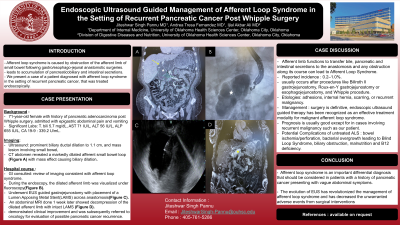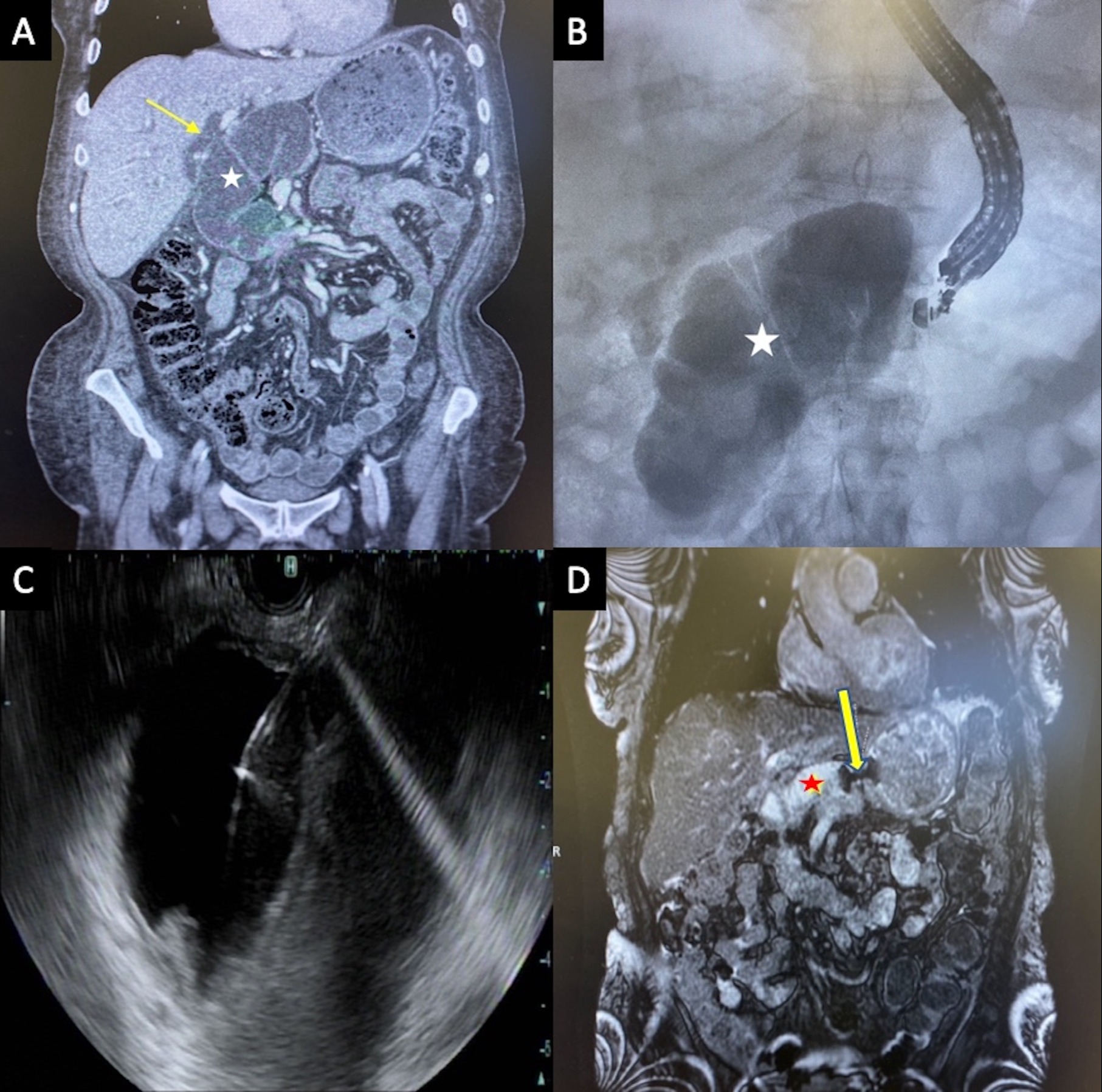Sunday Poster Session
Category: Interventional Endoscopy
P0879 - Endoscopic Ultrasound Guided Management of Afferent Loop Syndrome in the Setting of Recurrent Pancreatic Cancer Post Whipple Surgery
Sunday, October 22, 2023
3:30 PM - 7:00 PM PT
Location: Exhibit Hall

Has Audio
.jpg)
Jiteshwar S. Pannu, MD
University of Oklahoma Health Sciences Center
Oklahoma City, OK
Presenting Author(s)
Jiteshwar S. Pannu, MD1, Andrea T. Fernandez, MD1, Ijlal A. Ali, MD2
1University of Oklahoma Health Sciences Center, Oklahoma City, OK; 2University of Oklahoma College of Medicine, Oklahoma City, OK
Introduction: Afferent loop syndrome (ALS) is caused by obstruction of the afferent limb of small bowel following gastro/esophago-jejunal anastomotic surgeries which leads to accumulation of pancreaticobiliary and intestinal secretions. Herein, we present a patient diagnosed with ALS with biliary obstruction in the setting of recurrent pancreatic cancer post Whipple surgery, that was treated via an endoscopic gastrojejunostomy (GJ).
Case Description/Methods: A 71-year-old female with history of pancreatic adenocarcinoma post Whipple surgery, was admitted with epigastric abdominal pain and vomiting. Lab work was significant for total bilirubin 5.7 mg/dL, AST 71 IU/L, ALT 56 IU/L, ALP 655 IU/L, CA 19-9 339.2 U/mL. CT abdomen revealed a markedly dilated afferent small bowel loop with mass effect causing biliary dilation. A diagnosis of ALS causing extrinsic biliary obstruction was made based on the known Whipple anatomy, suspicion for pancreatic cancer recurrence and careful review of imaging. The surgeons deferred any interventions and hence, endoscopy was planned. During the procedure, the dilated afferent limb was visualized under fluoroscopy and on EUS. An EUS guided GJ with placement of a Lumen Apposing Metal Stent (LAMS) across anastomosis was performed, with resultant expulsion of bilious fluid from the afferent limb. An abdominal MRI done 1 week later showed the decompressed afferent bowel loop with an intact LAMS. The patient demonstrated clinical improvement and was subsequently referred to oncology for evaluation of possible pancreatic cancer recurrence.
Discussion: The afferent limb functions to transfer bile, pancreatic and intestinal secretions to the anastomosis and any obstruction along the limb causes ALS. It has a reported incidence of 0.2%–1.0% and usually occurs after procedures like Billroth II gastrojejunostomy, Roux-en-Y gastrojejunostomy or esophagojejunostomy, and Whipple procedure. Etiologies include adhesions, internal hernia, scarring, or recurrent malignancy, which is seldom apparent on abdominal imaging. While surgery remains the definitive treatment, EUS guided therapy has revolutionized the management of ALS and has decreased the unwarranted adverse events from surgical interventions. Prognosis is usually good except in cases involving recurrent malignancy. If left untreated, it can lead to serious complications such as bowel ischemia/perforation, bacterial overgrowth leading to blind loop syndrome, biliary obstruction, malnutrition and vitamin B12 deficiency.

Disclosures:
Jiteshwar S. Pannu, MD1, Andrea T. Fernandez, MD1, Ijlal A. Ali, MD2. P0879 - Endoscopic Ultrasound Guided Management of Afferent Loop Syndrome in the Setting of Recurrent Pancreatic Cancer Post Whipple Surgery, ACG 2023 Annual Scientific Meeting Abstracts. Vancouver, BC, Canada: American College of Gastroenterology.
1University of Oklahoma Health Sciences Center, Oklahoma City, OK; 2University of Oklahoma College of Medicine, Oklahoma City, OK
Introduction: Afferent loop syndrome (ALS) is caused by obstruction of the afferent limb of small bowel following gastro/esophago-jejunal anastomotic surgeries which leads to accumulation of pancreaticobiliary and intestinal secretions. Herein, we present a patient diagnosed with ALS with biliary obstruction in the setting of recurrent pancreatic cancer post Whipple surgery, that was treated via an endoscopic gastrojejunostomy (GJ).
Case Description/Methods: A 71-year-old female with history of pancreatic adenocarcinoma post Whipple surgery, was admitted with epigastric abdominal pain and vomiting. Lab work was significant for total bilirubin 5.7 mg/dL, AST 71 IU/L, ALT 56 IU/L, ALP 655 IU/L, CA 19-9 339.2 U/mL. CT abdomen revealed a markedly dilated afferent small bowel loop with mass effect causing biliary dilation. A diagnosis of ALS causing extrinsic biliary obstruction was made based on the known Whipple anatomy, suspicion for pancreatic cancer recurrence and careful review of imaging. The surgeons deferred any interventions and hence, endoscopy was planned. During the procedure, the dilated afferent limb was visualized under fluoroscopy and on EUS. An EUS guided GJ with placement of a Lumen Apposing Metal Stent (LAMS) across anastomosis was performed, with resultant expulsion of bilious fluid from the afferent limb. An abdominal MRI done 1 week later showed the decompressed afferent bowel loop with an intact LAMS. The patient demonstrated clinical improvement and was subsequently referred to oncology for evaluation of possible pancreatic cancer recurrence.
Discussion: The afferent limb functions to transfer bile, pancreatic and intestinal secretions to the anastomosis and any obstruction along the limb causes ALS. It has a reported incidence of 0.2%–1.0% and usually occurs after procedures like Billroth II gastrojejunostomy, Roux-en-Y gastrojejunostomy or esophagojejunostomy, and Whipple procedure. Etiologies include adhesions, internal hernia, scarring, or recurrent malignancy, which is seldom apparent on abdominal imaging. While surgery remains the definitive treatment, EUS guided therapy has revolutionized the management of ALS and has decreased the unwarranted adverse events from surgical interventions. Prognosis is usually good except in cases involving recurrent malignancy. If left untreated, it can lead to serious complications such as bowel ischemia/perforation, bacterial overgrowth leading to blind loop syndrome, biliary obstruction, malnutrition and vitamin B12 deficiency.

Figure: Figure A: CT abdomen revealing a markedly dilated afferent small bowel loop (white star) with mass effect causing biliary dilation (yellow arrow); Figure B: Dilated afferent limb (white star) visualised under fluoroscopy;
Figure C: EUS showing the dilated afferent small bowel loop;
Figure D: Repeat abdominal MRI showing the decompressed afferent bowel loop (red star) with an intact LAMS (yellow arrow).
Figure C: EUS showing the dilated afferent small bowel loop;
Figure D: Repeat abdominal MRI showing the decompressed afferent bowel loop (red star) with an intact LAMS (yellow arrow).
Disclosures:
Jiteshwar Pannu indicated no relevant financial relationships.
Andrea Fernandez indicated no relevant financial relationships.
Ijlal Ali indicated no relevant financial relationships.
Jiteshwar S. Pannu, MD1, Andrea T. Fernandez, MD1, Ijlal A. Ali, MD2. P0879 - Endoscopic Ultrasound Guided Management of Afferent Loop Syndrome in the Setting of Recurrent Pancreatic Cancer Post Whipple Surgery, ACG 2023 Annual Scientific Meeting Abstracts. Vancouver, BC, Canada: American College of Gastroenterology.
